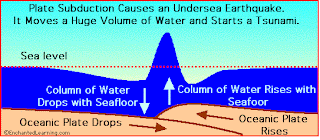What is a tsunami? Everyone must have heard of tsunami which has become a hot topic over the past few days. The recent tsunami that hit Japan last week is the largest tsunami catastrophe in the history of tsunamis in Japan, about 140 years. The resultant tsunami from a magnitude 8.9 earthquake that struck off the coast of Honshu, Japan, not only devastated the island nation, but also caused destruction and fatalities in other parts of the world, including Pacific islands and the U.S. West Coast.
First of all, what is this tsunami? Literally, in Japanese, tsunami means harbor wave. A tsunami is a series of ocean waves that sends surges of water, sometimes reaching heights of over 100 feet (30.5 meters), onto land. These walls of water can cause widespread destruction when they crash ashore. Owing to the immense volumes of water and the high energy involved, tsunamis can devastate coastal regions.
One might ponder what causes tsunami. There are basically many reasons why tsunami could occur. Earthquakes, volcanic eruptions and other underwater explosions (including detonations of underwater nuclear devices), landslides and other mass movements, meteorite ocean impacts or similar impact events, and other disturbances above or below water all have the potential to generate a tsunami.
For example in the event of an earthquake, when the ocean floor at a plate boundary rises or falls suddenly it displaces the water above it and launches the rolling waves that will become a tsunami. Most tsunamis, about 80 percent, happen within the Pacific Ocean’s “Ring of Fire,” a geologically active area where tectonic shifts make volcanoes and earthquakes common.
Tsunamis race across the sea at up to 500 miles (805 kilometers) an hour—about as fast as a jet airplane. At that pace they can cross the entire expanse of the Pacific Ocean in less than a day. And their long wavelengths mean they lose very little energy along the way.
In deep ocean, tsunami waves may appear only a foot or so high. But as they approach shoreline and enter shallower water they slow down and begin to grow in energy and height. The tops of the waves move faster than their bottoms do, which causes them to rise precipitously.
A tsunami’s trough, the low point beneath the wave’s crest, often reaches shore first. When it does, it produces a vacuum effect that sucks coastal water seaward and exposes harbor and sea floors. This retreating of sea water is an important warning sign of a tsunami, because the wave’s crest and its enormous volume of water typically hit shore five minutes or so later. Recognizing this phenomenon can save lives.
A tsunami is usually composed of a series of waves, called a wave train, so its destructive force may be compounded as successive waves reach shore. People experiencing a tsunami should remember that the danger may not have passed with the first wave and should await official word that it is safe to return to vulnerable locations.
Tsunami not only damages property but also causes terrible life loss. For example in 2004 Indian Ocean tsunami, more than 200 000 death was reported. The high death and casualty rate was due absence of tsunami warning system and lack of awareness about tsunami. Many people have not even heard about tsunami before tsunami happened in 2004.
There is nothing much we can do to fight this Mother Nature cause and the best defense against any tsunami is early warning that allows people to seek higher ground. The Pacific Tsunami Warning System, a coalition of 26 nations headquartered in Hawaii, maintains a web of seismic equipment and water level gauges to identify tsunamis at sea. Similar systems are proposed to protect coastal areas worldwide. This advance in technology has made it possible to save thousands of lives in the recent tsunami in Japan where less than 10,000 deaths has been reported.




No comments:
Post a Comment